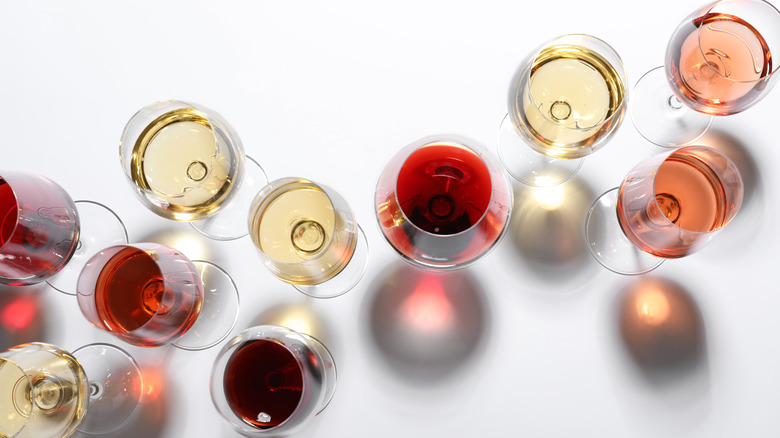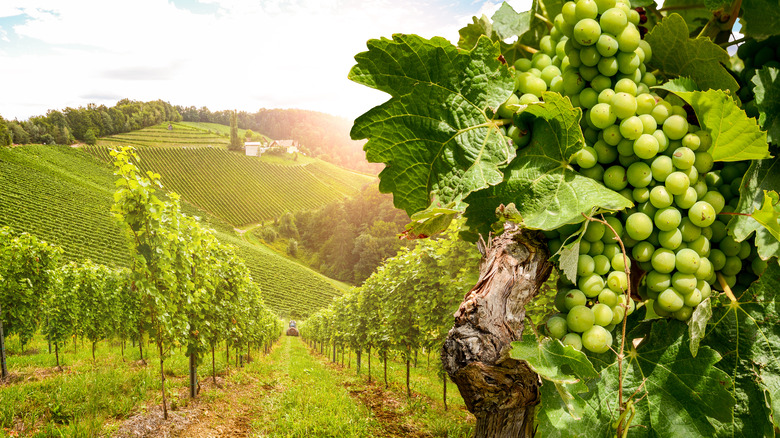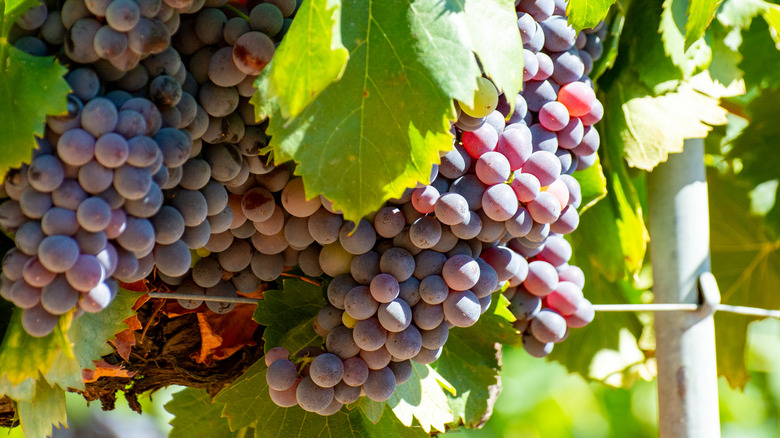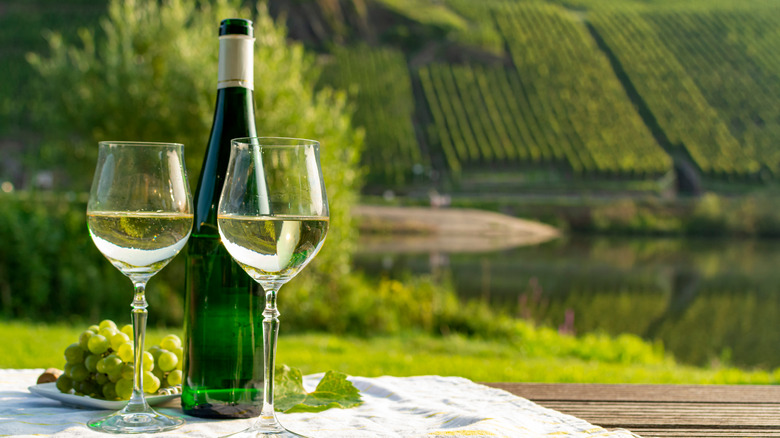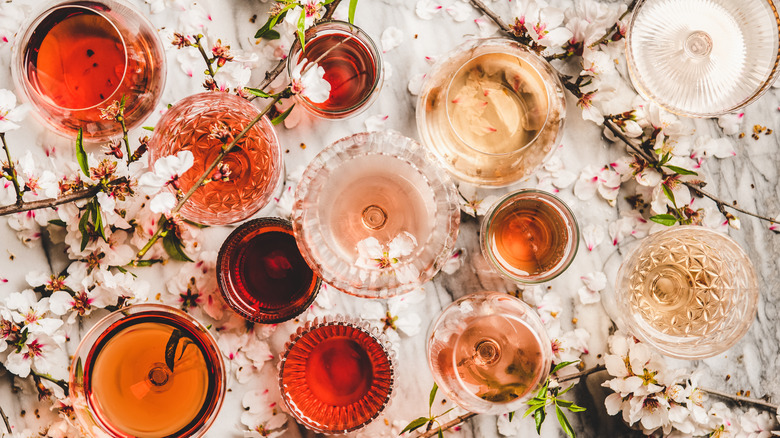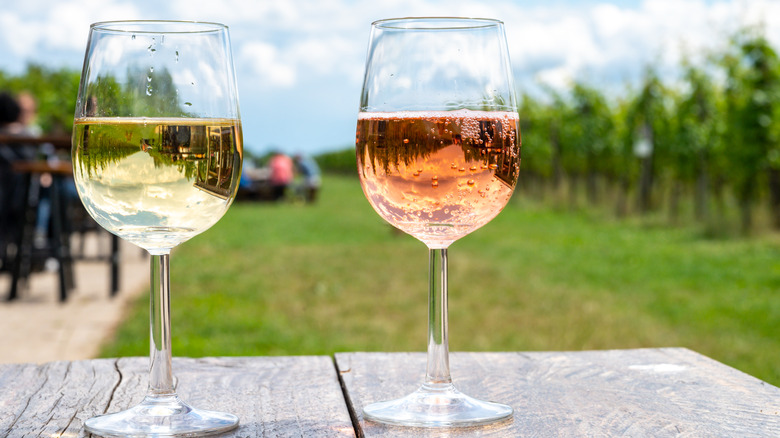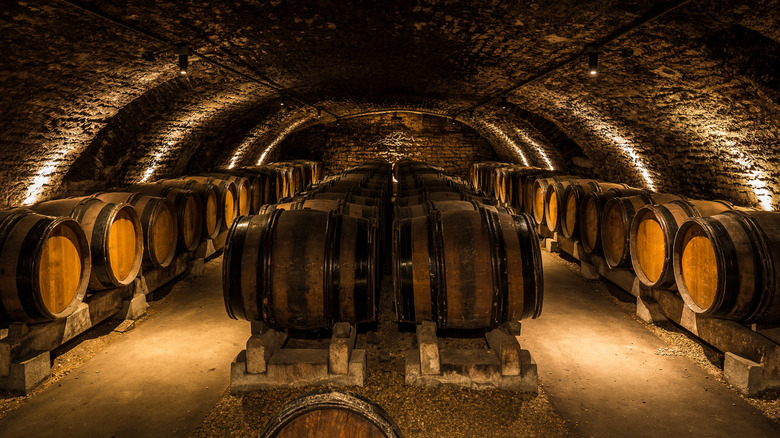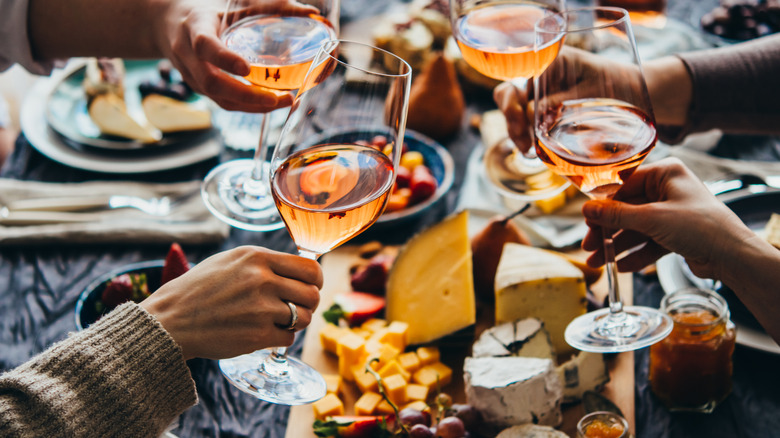White Wine Vs. Rosé?: What's The Difference?
We may receive a commission on purchases made from links.
While a glass of full-bodied red wine might be just the right accompaniment to an evening cozying up by your fireplace, longer, warmer days call for something more refreshing. White and rosé wine are perfect options for summer — and even have their place in your glass all year round. The cheeky response when asked what makes the two types of wine different is clearly their color. White wine ranges from almost transparent to deep golden, whereas rosé wine can vary from a pale salmon hue to a deep pink.
The more telling question is what makes the colors vary so widely. Decanter explains that grape juice is a clear liquid, and the amount of time the juice rests on the grape skins is responsible for the color of the resulting wine. A lighter-colored wine will have spent less time in contact with grape skins, while a darker wine will spend more time fully soaking in the pigments. On top of the time spent on the skins, Decanter points out that the growing conditions and ripeness of the grapes will also be reflected in the wine. One more consideration noted by the publication is that different grape varieties simply have thicker or thinner skins, which affects the amount of color they can impart to the juice.
So let's dive into how white and rosé wine are made, to understand why your glass of Chardonnay displays golden hues while your White Zinfandel pops with a bright pink tint.
How is white wine made?
White wine is made using grapes that usually have greenish skins, with a few exceptions such as Pinot Gris, which is more of a grayish pink color on the outside (via Wines.com). The skins used for white wine have little color to add to the juice compared with grapes used for red wine, which have deep purple and even black skins. On top of the minimal color originating from the grape skins, white wine is made by pressing the juice out of the skins and separating the solid parts from the grape juice (via Wines.com). This reduces further contact between the juice and the skins, minimizing any transfer of color. Orange wine is an example of white wine that has been made leaving the skins in the juice for an extended period, contributing to the final color.
Interestingly, white wine can be made using dark-skinned grapes, with the prime example being Blanc de Noirs Champagne, according to Wine-Searcher. The site explains that two dark-skinned grapes, Pinot Meunier and Pinot Noir, are pressed ever so delicately to obtain juice without exposing it to the pigments from the skins. While rosé Champagne is another story, many of the finest examples of Champagne are made from red grapes.
How is rosé wine made?
Rosé wine is made using typical red wine grapes, with some more suited to the style. The only distinction between a rosé Malbec and a deep red Malbec that you'd pair with your Argentinian steak, is how long the juice was in contact with the grape skins (via MasterClass). Wine Enthusiast explains that grapes designated for rosé production are usually picked earlier to keep the acidity and fruitiness intact. The source describes that grapes are then crushed to draw out the juice, which sits on the skins anywhere from a few hours to a week, depending on the desired color.
Meanwhile, for extra pale rosés such as the ones coveted in Provence in the south of France, the direct-press method is used. Wine Enthusiast compares it to white wine production, since the grapes are pressed and the juice is immediately separated from the skins, with no time to mingle with the pigments and only a touch of color imparted when the skins break.
Finally, the saignée method is used to make bolder rosés, and is a component of certain styles of red winemaking. Wine Folly details how red grapes are crushed and the lighter juice that is initially extracted is bled off (saignée in French) into a separate tank in order to concentrate the resulting juice into a heartier red wine. Saignée rosé is richer and fruitier and a good stepping stone for people who think rosé is too light.
Are red and white wine ever blended to make rosé?
Blending red and white wine together to make rosé sounds like a joke to anger wine aficionados, but one of the most prestigious styles of wine is usually made this way. Vinepair describes that rosé Champagne can be made by keeping red grape skins in contact with the juice for a short period of time, but it is more commonly made by blending up to 15% of red wine into white Champagne. Not only is the color of the wine enhanced, but MasterClass describes the flavor of rosé Champagne as being more aromatic and pronounced than the classic style of bubbles.
Some avant-garde producers, outside of the stricter traditional boundaries that define the laws of winemaking across Europe, might experiment with blending reds and whites. However, MasterClass reports that Champagne is the only place in Europe where the technique is allowed by law. Rules for wine are generally not taken lightly!
What does white wine taste like?
GuildSomm indicates that white wine made in cool climates will generally be fresher, crisper, and with more acid, compared with one made in a warmer climate. Meanwhile, the site explains that grapes grown in warmer climates will exhibit more tropical fruits, luscious rich flavors, and a fuller body. Just like any fruit, grapes need sun and heat to ripen, and express different aromas depending on their maturity. This is true even for the same grape variety. An interesting experiment to test this is to buy a Chardonnay from Chablis, France, and compare it with one from Napa, California.
Whether the white wine was aged in an oak barrel can have a huge effect on the taste, and Wine Folly notes it can introduce a slew of flavors such as vanilla, caramel, and cloves. Therefore, white wine can be greatly affected by what the winemaker chooses to do with the juice, and whether the grapes have received plenty of sunshine.
Another aspect of winemaking, which can have a large impact on the taste of white wine, is malolactic fermentation. Winc explains that malic acid (responsible for the tart flavor of green apples) is converted into lactic acid (found in milk products), thanks to the action of friendly bacteria. While the wine doesn't turn into milk, Winc describes that the tangier acidic flavors are softened and develop into creamy, buttery aromas. Have you ever enjoyed a buttery Chardonnay? If yes, you can thank malolactic fermentation.
What does rosé wine taste like?
Rosé wine can be produced in various ways, with less skin contact resulting in a lighter, fresher wine more akin to a white, and more skin contact approaching the depth and intensity of a fruity red wine. Since dozens of grapes can be used to make rosé, there is no typical flavor, and it depends on the grape, region, method of production, and winemaker's influence. However, MasterClass notes that many styles have notes of red fruits, particularly strawberries, melon, and floral aromas.
Though you might have been tricked into thinking that darker rosé meant a sweeter wine, you should now realize that the color only depends on the amount of time the skins were in contact with the juice. Some rosés are indeed sweet, but Bon Appétit points out that sweetness occurs if actual sugar is added, or if all the natural sugars in the wine are not fermented to alcohol.
It is less common for rosé wine to go through malolactic fermentation because a tart freshness is usually desired, according to Scott Laboratories. Equally, new oak imparting plenty of flavor is used less frequently with rosé, because Drinks Business explains that it tends to mask the fruitier aromas so pleasant in the wine. Nevertheless, winemakers are branching out and no longer looking to only make easy drinking, refreshing rosé for summer, and the site describes how oak-aged rosé is a great match for stronger flavors in food.
Is rosé or white wine better for you?
Before you run off and buy cases of rosé wine based on the following point, let's set things straight by mentioning that no wine is good for you in excess. The CDC defines moderation as up to one drink for women (5 ounces of wine) and up to two drinks for men per day.
Livestrong explains that the suggested benefits of wine come from resveratrol, an antioxidant present in grape skins. If you've read everything up to here, then you know that white wine has very little to do with grape skins. Therefore, the majority of the health claims associated with wine are not identified in white wine. Livestrong reports a 13% increase in cancer risk for regular white wine drinkers compared to red or rosé.
Rosé, on the other hand, does come into contact with grape skins and can contribute to a decrease of various conditions including high cholesterol, high blood pressure, inflammation, and heart disease, according to Livestrong. Consequently, darker rosés are healthier than extremely pale versions. While we wouldn't recommend "Rosé all day," it's worth it to note that replacing some of your white wine consumption with rosé will have its advantages.
Which is more expensive?
According to Wines of Provence, the most expensive rosé wine is under 200 euros, or a bit over 200 dollars. The source notes that prior to this release, the most expensive rosé was about half the price, highlighting the fact that pink wine is rarely considered to be as prestigious as its white and red counterparts. Forbes remarks that rosé has consistently been marketed as light, refreshing, easy wine for summer, meant to drink immediately.
Conversely, white wine receives plenty of praise, (albeit not as much as red), and wine critic Jancis Robinson notes many examples of whites that age well, making them more valuable to wine collectors. At $117,000, a bottle from 1811 by the esteemed producer Château d'Yquem received the Guinness World Record for the most expensive bottle of white wine ever sold. Granted, most white wines don't reach this level of inflated luxury, but even Burgundy whites regularly top $100, according to The Buyer.
An exception to the heftier price tag of white wines, is rosé Champagne. Wine reviewer Natalie Maclean explains that the production is more tedious, requiring more work and time, which is automatically transferred to a pricier wine for the consumer. She describes that blending the same color yearly is actually the trickiest part, since the aim of house Champagne is to have a stable style over time.
Are they paired with different foods?
There is definitely an overlap in food pairings between white and rosé wines. This is especially true of paler styles of rosé that exhibit crisp, citrusy flavors, comparable to fresh white wines from cooler climates. These wines will match well with seafood, grilled fish, charcuterie, vegetables and salads, and light pasta dishes, according to the pros at Matching Food and Wine.
Darker, fuller-bodied rosés will be able to stand up to stronger flavors, and can be a fun option to pair with red meat and tomato-based dishes such as pizza. MasterClass even recommends sweeter rosés with barbecued or roasted meats, to provide a contrast in flavor. Off-dry rosé or white wines are always a good choice for spicy curries, since they offset the heat (via Decanter).
Finally, beyond expert recommendations and carefully designed wine and food pairing charts, the best pairing is the one that you like (and hopefully the one in your glass). So don't worry if you don't stick to classic pairings and decide to step outside of the box when choosing your wine for dinner. You might come up with your new favorite match.
